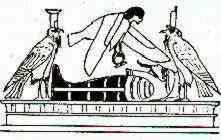PYRAMID TEXTS, COFFIN TEXTS, AND THE BOOK OF THE DEAD

PYRAMID TEXTS (dating from 2400 BC)
The Pyramid Texts constitute the oldest surviving body of Egyptian religious and funerary writings available to today. They are a collection of Egyptian mortuary prayers, hymns, and spells intended to protect the dead king or queen and ensure life and sustenance in the hereafter. These texts are found inscribed on the walls of the inner chambers of the pyramids during the Old Kingdom. ( Remember The Great Pyramid does not have any inscription of any kind except the alleged cartouche of Khufu discovered by Colonel Vyse in the King’s relieving chamber). Some of the pyramids, which contain these texts, are found at Saqqarah in several 5th and 6th dynasty pyramids. The earliest known is that in the pyramid of the last king of the 5th dynasty, Unas.
COFFIN TEXTS (dating from 2000 BC)
By the time of the Middle Kingdom, a collection of these kind of texts were being inscribed on coffins, available to anyone who could afford them, not just the King’s. Thus the name Coffin Texts.
BOOK OF THE DEAD (16th Century BC)
In the New Kingdom and later they were written on papyrus rolls or sometimes on leather. These rolls are known to us as the Book of the Dead. The texts often contained colorful illustrations and were sold to individuals for burial use. They are not uniform in content or arrangement and no two copies are exactly alike. Numerous authors, compilers, and sources contributed to the work. They not only differ in choice of spells, but the same spell may differ from one manuscript to another. These spells are in effect magic formulae, which enable the deceased to pass from the tests and dangers, confronted after death. Since the spells are from many different sources, no uniform idea of the afterlife may be gained. Of the copies found in Egyptian tombs, none contain all of the approximately 200 known chapters. The collection, entitled "The Chapters of Coming Forth by Day", received its present name from Richard Lepsius, German Egyptologist who published the first collection of the texts in 1842.
There are many variations of the afterlife. Here are a few:
- The deceased regains the use of his mortal body and enjoys life as before. –OR
- He joins the sun god Re (Ra) as he traverses the heavens. –OR
-He is transformed into a swallow, a serpent, or a crocodile. –OR
- He becomes the god Osiris, primeval creator of all.
EGYPTIAN RELIGIOUS BELIEFS
The Pharaoh's ascent to heaven
The Pyramid Texts almost exclusively are concerned with the postmortem destiny of the King. As we mentioned above the doctrine was not systematized but we find many variations.
The majority of texts state that the Pharaoh, son of Re, brought into existence by the Great God before the creation of the world, cannot die. In other texts, they only assure that his body will not suffer decomposition. These two different ideologies have not adequately been integrated into their religious system. However, the majority of texts refer to the pharaoh's celestial journey. He flies away in the form of a bird, a falcon, a heron, a wild goose, a scarabaeus, or a grasshopper. The winds, the clouds, and the gods are bound to help him. In certain texts the King ascends to the sky by a ladder. During his ascent the king is already a god and is different in essence from human beings.
Now the goal of the Pharaoh was to arrive at the celestial abode in the East, named the Field of Offerings. Before arriving he had to undergo certain ordeals. The entrance was defended by a lake "with winding shores", and the ferryman had the power of a judge. To be admitted into the boat, the pharaoh must have completed all the required ritual purifications. He must also specifically answer questions by stereotyped formulas that served as passwords. Sometimes the King had recourse to magic or to pleading, or even to threats. He implores the gods, (Re, Thoth, and Horus) and begs the two sycamore trees between which the sun rises every day to let him pass into the "Field of Reeds".
When the pharaoh arrives in heaven, he is received in triumph by the Sun god, and messengers are sent to the four quarters of the world to announce his victory over death. In heaven, the king continues his earthly existence. He is seated on the throne and receives the homage of his subjects and still judges and gives orders.